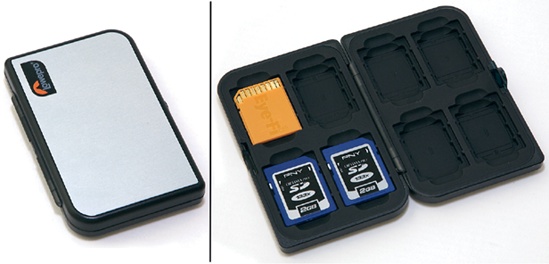In the old days, you pulled the film out of your camera and dunked it in toxic chemicals, or you hired someone else to do that for you. With a digital camera, of course, you don't need chemistry or lightproof rooms. Instead, after your shoot, you'll transfer your images to your computer where you can edit and correct them. You can perform this transfer in many ways, and lots of software exists that you can use for editing. In this chapter, we'll take a look at your transfer options and explore Canon's bundled software. Before we get started, let's consider your camera's media card.
Film is an amazing invention because it's a single material that can both capture an image and store it. With a digital camera, the image sensor does the capture, but it doesn't have any capability to store an image. For that, a digital camera employs a memory card of some kind. As you've already learned, the XS uses Secure Digital cards (or SDHC cards, a faster, higher-capacity version of SD).
Flash memory cards are similar to the RAM that's in your computer but with one important difference: They don't require power to remember what's stored on them. So, after you turn the camera off, the images remain on the card, even if you remove it. Consequently, it's perfectly safe to take out a full card and replace it with another.
Your camera treats the card just the way your computer treats your hard drive. The camera creates folders on the card and stores files in those folders, each with a different name.
Because cards are so small and because they can pack huge capacities, it's possible to shoot a tremendous number of images with just one or two cards. In fact, because the XS's battery is good for "only" about 500 shots, if you're carrying a couple of high-capacity cards, you'll probably run out of battery before you run out of storage.
With the range of capacities available, you can carry storage in several ways. You can get a few high-capacity cards or more lower-capacity cards. The advantage of a high-capacity card is that your shooting won't be interrupted with a card change. The risk, though, is that if something happens to the card, all your images will be lost.
Though it's rare, a Secure Digital card can be corrupted. Sometimes static electricity can do it; sometimes a glitch in your computer or in your camera can mess up a card. While the card probably won't be permanently damaged, its contents can be rendered unusable. So, you might want to consider using more, smaller cards so that if one goes bad, you won't lose as many images.
For maximum flexibility, you might want a combination: a big card that you can use when you're shooting events—such as a performance or sporting event—and don't want to miss shots because of a card change, and smaller cards that you use for everyday shooting. You may have to change them more often, but your images will be safer in the event of a card failure.
When you're in the field, you'll need to keep track of which cards you've used and which are available for shooting. If you're shooting on-the-go, you don't want to have to worry about whether the card you're about to use already has images on it. You can ease your card management hassles when shooting in a few ways.
First, after you transfer your images to your computer, erase the card. We'll look at how to do this later in this chapter. After you've transferred images, if you just throw the cards back in your camera bag with the idea of erasing them when you're ready to use them, you can easily end up confused as to whether the card has already been transferred. If you become uncertain, you might be less willing to use the card, and then you can end up short on storage. Also, if you erase beforehand, when you put the card in the camera, it's ready to use, right away.
Second, if you have a camera bag with a lot of pouches and compartments, consider using one pouch for unused cards and another for used cards. This makes it simple to keep track of which media is ready for use.
I carry my cards in a small holder. When I fill up a card, I place it back in the holder, facedown. That way, I can easily see how many cards are remaining and be certain that I'm grabbing a card that's ready for use. I use a holder made by LowePro (www.lowepro.com).
Figure 4-1. A card holder can make it much easier to manage your cards while shooting. Upside-down cards are full; face-up cards are ready for use.
At some point, though, your cards will be full, and you'll be ready to transfer your images to your computer.
Get The Canon EOS Digital Rebel XS/1000D Companion now with the O’Reilly learning platform.
O’Reilly members experience books, live events, courses curated by job role, and more from O’Reilly and nearly 200 top publishers.



